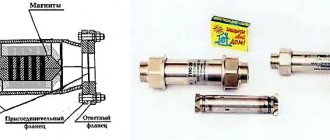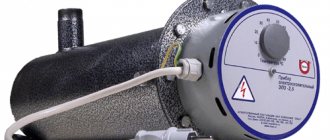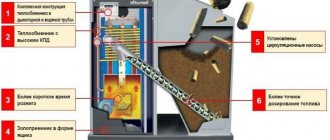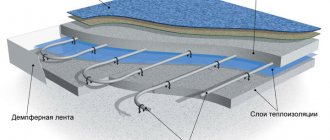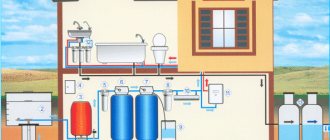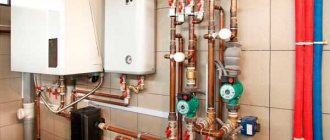In apartments of multi-storey buildings, individual heating is installed due to unsatisfactory heating from the central network. Technically, it is not difficult to implement the idea, and many property owners turn to authorities to refuse the services of a local organization that supplies heat to the multi-apartment sector.
Install individual heating in your home
Compliance with the law during installation
The legality of using an autonomous unit to supply heat to a separate apartment gives rise to many disputes. In 2010, disconnection from the general heat supply main was prohibited by the Russian government. The installation of individual complexes for heating rooms in multi-storey buildings is also blacklisted.
But in 2012, a new decree on regulations for connecting heating systems provided a list of heat sources prohibited in an apartment . Certified heating boilers are not indicated in this list. From now on, it is allowed to install individual heating in your own living space. Restrictions affect the technical characteristics of the units.
Free independent placement of heating devices and re-equipment of the existing pipe system are not allowed. To obtain a permit, contact the local municipality. Sometimes Art. 14 of the Federal Law “On Heat Supply”. In this case, the apartment owner has the right to appeal to the courts.
In this video we will look at a gas boiler in an apartment:
What to do?
Thus, each apartment owner independently decides whether to separate from the others or not. But if you can’t decide what to do in this case, then just think and weigh the pros and cons. If you have an old-style low-rise apartment building that is equipped with chimneys, then you can safely switch to autonomous heating.
Boiler room of an apartment building
If all your neighbors want to secede, then there may be two options. It is possible to carry out a major reconstruction of the house - equip chimneys and internal gas pipelines, and a complete heating system. This is a serious option that requires a lot of expense, but each resident will have their own boiler. Another option is installing a boiler room. That is, there will be one powerful boiler, for which there will be a special room. Residents only have to reconstruct the heating for this type of system and install meters. Although there will not be complete autonomy here, the main advantages are obvious: you set the temperature yourself and pay only for what you heat.
Connecting individual heating
If the housing is cold, then this fact is documented with the involvement of representatives of the housing office or the heat supplier. Before making individual heating in an apartment, to investigate the fact of unsatisfactory services, submit an application to the sanitary and epidemiological station or heating network office. Recording temperature violations will help in case of refusal and when going to court.
Project development
Together with the technical worker, the type of individual heating scheme is determined and the heating unit is selected based on strength. The power is assumed to be 100 W per square area. This is enough, because even an apartment in a corner location communicates with neighboring heated rooms through common walls that prevent the temperature from decreasing.
in project documentary developments :
- The type of wiring is determined by the total square footage of the housing. For small rooms, a single-pipe scheme similar to Leningrad is suitable; in large apartments, a two-pipe lower distribution is installed. Since wall-mounted electric or gas units with a built-in pump and expansion tank are most often installed, the pipe system will be a closed type with forced movement of the energy carrier.
- Method for dismantling old heating manifold wiring. The information concerns the connection to the batteries and the heating elements themselves. It is not allowed to touch the collectors of the common riser, and instead of the dismantled bypass, a straight section of connecting pipe is welded. According to the rules, thermal insulation is made for the remaining areas.
- A drawing of the new arrangement of all elements of the system, indicating the location of radiators, temperature-controlled valves, pipe laying, boiler installation, and removal of burned products. If there is a smoke shaft, then choose a generator with an open combustion type. If there is no outlet, a turbocharged unit is used with the installation of a coaxial pipe through the wall enclosure.
A double-circuit heat source will allow you to abandon the centralized supply of hot water and implement the idea of underfloor heating. If the overlap allows, then the pipes are laid in a screed. In another version, they are mounted between the joists and placed as a base under a decorative coating.
Sequencing
To prevent sudden power outages from disrupting heating, an uninterruptible supply device is provided. Installation work on wiring the system inside the apartment can be done independently. It is not allowed to connect the boiler to common electrical or gas mains. The order of sequential events is as follows:
- registration of refusal of general heating supply and permission to dismantle old pipes and radiators;
- obtaining documentary approval for the installation of an individual boiler by the relevant city services;
- selection of the type of apparatus and collector connection system;
- project development taking into account technical standards;
- agreeing on paperwork with the fuel supplier and obtaining permission;
- installation of the unit and all system elements on site.
Selecting a heat generator
An individual heating boiler in an apartment can be single-circuit or double-circuit.
The first type of units is used only for heating a room in cold weather. The second type additionally heats water for use in the bathroom or kitchen. Useful: how to choose a double-circuit wall-mounted gas boiler.
The installation method divides boilers into two types:
- Floor-standing units characterized by a long service life and high power ratings.
- Attachments are in high demand due to their built-in equipment, compactness and low cost.
Electrical sources are offered at a low price, and the devices are practically safe to use. There are no strict requirements for their installation; they are placed in various areas of the home. The downside to using electrical devices is that high-quality wiring is required. Sometimes, to use the devices, the cables in the entire apartment are changed and additional control shutdown devices are installed.
Gas units have a higher cost, which quickly pays for itself in the short term of operation. The installations contain sealed chambers for burning gas and venting the child outside, so residents do not experience any inconvenience.
Placement of a gas boiler
To strap the unit, all the requirements laid down in the project are fulfilled. Deviation from the standards will lead to difficulties in accepting work. Specialized organizations allow the placement of a gas boiler in an apartment subject to the following rules:
- The installation room should not be less than 4 m² in floor area;
- sufficient natural lighting is provided; according to the standards, for every 10 m² of a room, 0.3 m² of glazing is required;
- It is mandatory to install a window in the window opening or separately in the wall; hinged window sashes are not taken into account;
- the entrance to the room is not less than 0.8 m wide, the ceiling height is not less than 2.5 m, the presence of cold water supply is required;
- a grounding loop is arranged and the room is ventilated;
- The surface of the walls is smooth, finished with plaster.
If the installation location complies with the rules, then installation work begins. A gas generator for an apartment can be with gravitational movement of the coolant or with forced movement using an air blower. The burner is built-in standard or is made according to the principle of a modulating element. The second type regulates the size of the flame and the temperature of the antifreeze in the system or water supply.
Strapping scheme
During the gravitational movement of the energy carrier, physical laws apply; the flow is determined by the difference in the density of heated and cooled antifreeze. The open-action gravity circuit harness includes:
- accelerating manifold in the area after the boiler;
- open expander (tank);
- shut-off valves at the inlet and outlet.
Forced circulation produces pressure using an electric pump. Such a circuit is convenient to operate, since automatic adjustment of all parameters of the heating system is provided. The advantages are expressed in the rapid increase in liquid temperature, energy savings, and the possibility of organizing a heated floor. In mounted gas appliances, all the necessary circuit elements are installed in the structure and do not require separate purchase and connection.
Installation features
Installing a wall-mounted double-circuit gas unit for a city apartment is an acceptable option. The device provides simultaneous heating and water heating. Placement on a wall fence saves space. The kitchen always has equipped ventilation, running water, and gas supply (stove). With small areas of urban housing, placing the boiler in the kitchen meets most regulatory requirements.
For double-circuit units in a private house, a backup power station is provided; in a multi-story building this is not permissible, but an uninterruptible power supply is used, like for a laptop, only with more power. It is enough to work while troubleshooting power problems on the line.
The expansion tank serves to compensate for the volume of liquid when heated. The energy carrier increases, the excess enters the vessel, and after cooling it returns to the circuit.
Installation of gas equipment is not permitted in cases where:
- close to flammable systems and objects;
- in the bathroom due to air humidity;
- in the corridor due to the low supply of fresh atmosphere;
- in dorm rooms, shared basements and remote balconies;
- in a confined space where there are no windows.
Installation in premises at the ground floor level is allowed only after individual permission from the regulatory services.
When placed in urban housing, separate chimneys and normal air exchange are installed to obtain draft and improve combustion. The parapet-type gas apparatus is used by most of the population. There is no need to build a bulky smoke channel for the stove.
To deliver oxygen for combustion, a double-type horizontal pipe is made. The coaxial chimney provides simultaneous supply of atmosphere and removal of fumes. Air enters through the outer chamber and is discharged through the internal passage. The product is placed horizontally and taken out behind the wall. The material of the inner chamber is copper with a high thermal conductivity, and the efficiency of parapet devices reaches 90%.
Installation of a gas heating system
The gas heating system consists of the following parts:
- gas boiler;
- pipeline;
- radiators;
- additional components (Maevsky taps, pressure gauges, etc.).
If necessary, an expansion tank and a circulation pump are included in the heating circuit. Most modern models of gas boilers have these elements, but it happens that their capabilities are not enough to provide high-quality heating. Then purchase an additional pump or tank.
The installation of a heating system begins with the installation of a gas boiler according to all the rules, connecting it to the water pipes.
Radiators are installed under the window - they are hung on brackets that are embedded in the walls. The optimal distance from the floor and window sill is 10-12 cm. The gap between the wall of the house and the radiator should be at least 5 cm.
There are several options for connecting pipes to batteries:
- lower;
- one-sided;
- cross;
- single-pipe.
Optimal for heat transfer is a one-sided connection. Diagonal is used when the number of sections is more than 12, and heat loss in this case is minimal - about 2%. The lower connection is used when connecting the radiator to the floor screed, in which the heat-generating system is hidden, but heat loss increases up to 10%. The most unprofitable option is single-pipe.
It is advisable to install a Mayevsky tap, a plug and foot nuts on each radiator.
The tap should be located on the right side, the plug on the left. Shut-off and control valves should be installed into the lower pipelines. Important! When installing, radiators should be centered.
If they are installed at an angle, this will increase fuel consumption or lead to a complete lack of functionality. If the battery is tilted towards the Mayevsky tap, then it will not be possible to expel air from the system. After installing all the radiators, they proceed to laying the pipeline. It can be made open or closed. The first method is classic and the simplest: pipes are laid along the walls above the floor and secured with clips. The disadvantage is the unaesthetic appearance of the pipe.
The second method is to install pipelines invisibly. If insulation is planned, they are hidden under drywall or other insulation. In another case, the device involves gating walls or floors. Pipes located under the insulation or in the wall must be additionally insulated with Merylon, which makes it possible to reduce heat loss and leave space for thermal expansion.
For autonomous heating devices, pipes with a diameter of ¾ inches are used, and for connecting batteries with a tee, pipes with a diameter of ½ inch are used.
Gas boiler wiring diagram -
Boiler for a double-circuit gas boiler - built-in, indirect or electric
Electric boiler
To choose a unit that uses electricity, get acquainted with the technical parameters and settle on the most acceptable indicators. Single-circuit boilers are used as an additional heating circuit, in contrast to double-circuit devices, which have 2 functions. What is common in the design of all heating electrical appliances is that they are fully equipped; the devices are installed independently, without the participation of craftsmen.
The internal contents of the units vary depending on the type of heating elements. These can be electrodes, induction coils, heating elements, etc. It is the type of heater that provides the required power and determines the optimal choice. Dual-circuit devices have storage elements, which saves energy. For apartments, devices with a throughput capacity of 8 liters per minute are often purchased. There are domestically produced units for which an additional pump, pipe distribution group and cable are purchased.
How to choose power?
A pre-calculation of the power of the required gas boiler for an apartment will allow you to confidently navigate when choosing a device in a store. Manufacturing commercial organizations make complex calculations, taking into account all the necessary indicators, in order to install the heating system as efficiently as possible. For private residential premises the situation is simpler.
The easiest way to calculate the required boiler power is to use the calculator on the manufacturer’s website by entering the required temperature, room area, number of floors and other housing indicators. The result will be a fairly accurate indicator of the power of the equipment required for a particular building. All this data can be collected by walking around the apartment, but some require looking at the technical passport of the living space, for example, the thickness of the building’s external wall and the type of floors.
Installation norms and rules
To install a standard electric fuel boiler with a power of 220 volts, the room is not converted, but some recommendations regarding the sequence of actions are taken into account:
- before placing on the wall, measure the height and cut out grooves for laying the wire and distribution panel or box;
- the boiler is mounted on the fence in accordance with the instructions, the cables are put into the grooves and the wiring area is finished with mortar;
- the unit is connected to the outlet pipes of the heating system and electrical wiring;
- in order to ensure the profitability of the heater (monthly operating cost), it is necessary to provide for electricity consumption in the amount of the limited limit specified in the contractual obligations;
- This is done after purchasing and installing a programmer or control thermostat to reduce heating at night or in an empty home.
A double-circuit electric unit is in demand for heating apartments in the high-rise sector, because... does not require large expenditures, is safe to operate, cost-effective, and does not require special skills during installation.
What devices will be required?
Gas companies are actively inviting owners of houses and apartments to switch to separate heating, but no one warns what difficulties applicants for individual heating will have to face. So, the user will have to spend money on the following equipment:
- boiler (upon granting permission, the person will be offered the parameters of a heating device that can be installed in a specific apartment, taking into account the technical features of the housing);
- meters and other elements for calculating gas consumption for heating housing;
- a separate system for capturing air from outside, which protects the air space inside the room;
- pipes necessary for the removal of combustion objects.


